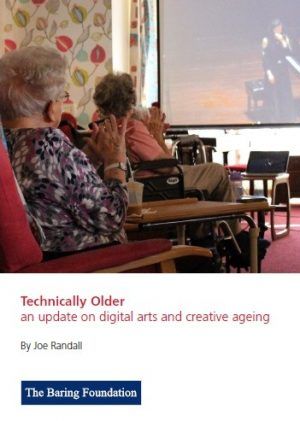We are all makers; whether we make food, objects, teams, businesses or art. It’s all in us.
The Digital Makers project has a simple objective: to tap into the inner maker and empower older people to make art using the latest digital manufacturing technology. Through making with each other, we build a sense of community and also open up opportunities to create new relationships, develop skills and learn from one another. Older artists can be considered outdated, which is something that the Collective actively challenges with their willingness to try new techniques.

Digital Makers happens in a FabLab – short for Fabrication Laboratory – a place where you can make almost anything – from simple laser-cut paper art, to 3D printed prosthetic hands, with machines for cutting, 3D printing, electronics and computing. It’s part artist studio, part 21st century workshop and part ideas space. Needless to say, it’s an exciting and creative way to explore new technology and the world of digital manufacturing.
Digital Makers runs out of FabLab Belfast, an open access maker space situated on the peace lines in North Belfast, and specialises in ways to creatively use digital technologies to help bridge the deep divisions between communities left as a legacy of the Northern Irish conflict.
The concept behind Digital Makers is to give older people from these communities an opportunity to meet make and learn together by establishing a Digital Makers Collective, which will develop skills, make new digitally inspired work, and exhibit these in a Belfast gallery. In addition we’ll all pack up a mobile FabLab for creative taster workshops in digital making to take out to community venues and care homes across the city.
This is not without its challenges – making art with Digital Manufacturing is not only about using design software, but also about visualising how the object will develop between what you make on screen and what you hold in your hand.
It is at this point that the veil into the digital realm is lifted, and the participants must follow the white rabbit down into a new and often confusing world as hand drawn images are scanned in, edited in software before being fabricated at one of the machines in the Lab. I have witnessed the ‘a-ha’ moment where the participants can begin to translate how to make an image in this odd in-between space: the intimidating screen space. This is a place where things are just out of reach and don’t feel ‘real’, before the alchemy of the laser cutter, vinyl cutter or 3D printer gets to work.
William, a member of our Digital Makers Collective, had never used a computer before. For our first session, we stayed in his comfort zone, simply drawing pen and ink illustrations whilst plying him with biscuits and cups of tea with a generous helping of craic. Building this rapport at the beginning in an informal atmosphere where it’s OK to ask questions is so important, and starting off a little more slowly allowed him to feel comfortable to give it a go. When asked what he enjoys most about the Collective, William writes, “The tea and biscuits. The friendly company. The well laid out workshop. The tea pot.”

I’d be inclined to agree!
William is currently working on automata, which are kinetic sculptures which you move with a crank. These are currently hand drawn, but he is now pushing his own boundaries into 3D design and aims to work towards 3D printing all of the moving parts.
Another workshop participant, Alan, uses his time to explore ideas of spirituality using the ‘Om’ symbol that helps to calm the mind and bring stillness to the present moment. He originally explored the ‘Om’ shape as simple block shapes which he hand drew, however this idea of the physical realm and the spiritual realm being imbued in the object in some way pushed us to think more about how to represent this. So Alan went back to the drawing board and redrew the ‘Om’ drawing to contain lots of little circles – so the form, the outline, was balanced by the formlessness within. The idea of allowing the participants agency over their own projects has proved crucial to the success of the project, as the participants have a sense of ownership and drive to complete their projects. I’ve realised that each of them needed to celebrate their individuality, their interests, and their stories.
In this final image, we return to William’s story and another first for him – the first time he’s allowed someone to take his photo in a long time. His artwork represents not only his journey into a new digital realm, but also came to be protective armour when the camera appears!
William and Alan belong to a diverse mix of older people in the Digital Makers Collective. Some of whom are artists who live in North Belfast who have been meeting each week for some time to draw and converse. Our other Collective members are people who have moved through the Get Making programme and shown great interest in learning more about making art using digital manufacturing tools. This blending of different people has created a lively and interesting group, and they often lend each other books, or go to events together, and we have been out for a number of gallery visits together. They are linked by their newness to using digital design software and digital manufacturing tools.
There is no other space like this in Northern Ireland which invests time in older artists making work digitally and this is an example of how creative approaches can be a catalyst for new digital tools.
The Digital Makers Collective is one of several grants made by the Foundation in a joint fund with Nominet Trust designed to increase older people’s involvement in the creative arts through digital tech.
